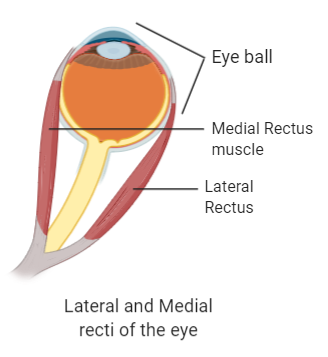
How many eye muscles are present which control all types of eye movement?
A. 3
B. 4
C. 5
D. 6
Answer
557.1k+ views
Hint: The muscles that control the movement of the eyes are called extraocular muscles. The action of these muscles is dependent on the eye position at the time of muscle contraction. The eyes must move to follow the target as only the small part called fovea provides sharp vision.
Complete answer:The eye is the key sensory organ of the body. It is through eyes we are able to see the wondrous beauty of this world. Only a small portion of the eye called fovea is the structure responsible for sharp vision. The eyes need to move to focus on the target. The elevation of the eyes, the downward gaze, and all other side movements are controlled by 6 muscles of the eye. These are called extraocular muscles. Eye movement is majorly done without conscious efforts. The vestibulo-ocular reflex plays an important role in the movement of the eyes.

The four of the extraocular muscles originate in the back of the orbit and these are called rectus muscles. They directly attach to the front half of the eye. The medial rectus is present close to the nose and helps in medial movement. The lateral rectus lies away from the midline and helps in the lateral movement of the eyes. The superior rectus helps in eye elevation and the inferior muscles help in downward gaze. Both of these muscles act in coordination and do not directly pull straight back on the eye.
The other two extraocular muscles are superior oblique muscles and inferior oblique muscles. The former activates when the eye is pulled downward laterally. The latter is involved in the upward and lateral eye movements.
Hence, from the above discussion, we can conclude that the right answer is option D.
Note: The ophthalmic artery is the main blood supply unit for the extraocular muscles. The nuclei for the nerve supply of all these muscles are found in the brainstem. The nucleus called the Abducens and the oculomotor generates respective cranial nerves that regulate these muscles.
Complete answer:The eye is the key sensory organ of the body. It is through eyes we are able to see the wondrous beauty of this world. Only a small portion of the eye called fovea is the structure responsible for sharp vision. The eyes need to move to focus on the target. The elevation of the eyes, the downward gaze, and all other side movements are controlled by 6 muscles of the eye. These are called extraocular muscles. Eye movement is majorly done without conscious efforts. The vestibulo-ocular reflex plays an important role in the movement of the eyes.

The four of the extraocular muscles originate in the back of the orbit and these are called rectus muscles. They directly attach to the front half of the eye. The medial rectus is present close to the nose and helps in medial movement. The lateral rectus lies away from the midline and helps in the lateral movement of the eyes. The superior rectus helps in eye elevation and the inferior muscles help in downward gaze. Both of these muscles act in coordination and do not directly pull straight back on the eye.
The other two extraocular muscles are superior oblique muscles and inferior oblique muscles. The former activates when the eye is pulled downward laterally. The latter is involved in the upward and lateral eye movements.
Hence, from the above discussion, we can conclude that the right answer is option D.
Note: The ophthalmic artery is the main blood supply unit for the extraocular muscles. The nuclei for the nerve supply of all these muscles are found in the brainstem. The nucleus called the Abducens and the oculomotor generates respective cranial nerves that regulate these muscles.
Recently Updated Pages
Master Class 11 Business Studies: Engaging Questions & Answers for Success

Master Class 11 English: Engaging Questions & Answers for Success

Master Class 11 Computer Science: Engaging Questions & Answers for Success

Master Class 11 Social Science: Engaging Questions & Answers for Success

Master Class 11 Maths: Engaging Questions & Answers for Success

Master Class 11 Biology: Engaging Questions & Answers for Success

Trending doubts
Differentiate between an exothermic and an endothermic class 11 chemistry CBSE

10 examples of friction in our daily life

One Metric ton is equal to kg A 10000 B 1000 C 100 class 11 physics CBSE

Difference Between Prokaryotic Cells and Eukaryotic Cells

State the laws of reflection of light

Explain zero factorial class 11 maths CBSE




